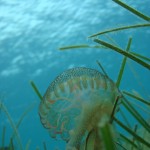The first MedSeA training activity focused on the use of CO2 vents for ocean acidification studies, and it was held on Vulcano Island, Sicily, Italy, on 25-27 May 2011. The local organizing team did an excellent job and was led by Marco MILAZZO, Salvatrice VIZZINI, Francesco PARELLO and Antonio MAZZOLA (CoNISMa–University of Palermo) with additional help from Jason HALL-SPENCER (University of Plymouth) and Maoz FINE (Bar Ilan University). The training activity was extremely successful, with theoretical and review lectures in the mornings on the chemical and physical effects of volcanic marine vents, the use of natural analogues for high CO2 conditions, physiological experiments at CO2 vents and work to date on the use of low pH/low saturation states in natural settings in the Mediterranean. These were followed by practical field sessions in the afternoons on the intertidal and subtidal coastal ecological shifts along CO2 gradients, physiological in situ experimentation, pelagic sampling and boat-based water chemistry monitoring plus the deployment of a range of loggers to monitor the system. Additional funding from the EUROCEAN program allowed the participation of 6 additional PhDs and postdocs external to the MedSeA consortium and a UK journalist was invited resulting in coverage in the media in France, Belgium, the UK and Italy. A total of 44 participants, including 12 research students, attended the workshop, from France, Germany, Greece, Israel, Italy, Morocco, Portugal, Spain, UK and the USA.
Riccardo Rodolfo-Metalpa introducing Pierre-Yves Cousteau to the CO2 vent system at Vulcano
Training and short-term field experiments by breakout groups focussed on macroalgae, seagrasses, benthic invertebrates and fishes. In addition, sampling for calcareous phytoplankton (coccolithophore studies) were performed in the surface waters of the natural CO2 gradient. This was a follow up of a pilot study showing high coccolith cell density and anomalous coccolith mophology nearby the CO2 vents. The local organizer for this activity was Alessandro INCARBONA (CoNISMa–University of Palermo) with the help of Patrizia ZIVERI (Universitat Autònoma de Barcelona), Elisa MALINVERNO (CoNISMa–University of Milano-Bicocca) and Gerald LANGER (Alfred Wegener Institute). Discussion and planning for future plankton experiments using the Vulcano CO2 vents as natural analogue for high CO2 conditions for studies was agreed and will start this year.
 To date, Ocean Acidification (OA) studies involve short-term, rapid perturbation experiments on isolated elements of the ecosystem (e.g. single species or small groups of species). It is difficult to imitate OA conditions in situ for sufficient periods to affect whole marine communities. Areas with naturally high CO2 can help show ecosystem responses to ocean acidification and should be harnessed to investigate long-term change on biogeochemical cycles. The aim of the workshop was to provide an opportunity for training as well as data collection. A major impact of the workshop was to open the eyes of a new cohort of young European scientists to the opportunities available to apply their techniques to natural CO2 gradients to scale-up from laboratory studies and improve predictions about the long-term effects of CO2 on coastal ocean system functioning.
To date, Ocean Acidification (OA) studies involve short-term, rapid perturbation experiments on isolated elements of the ecosystem (e.g. single species or small groups of species). It is difficult to imitate OA conditions in situ for sufficient periods to affect whole marine communities. Areas with naturally high CO2 can help show ecosystem responses to ocean acidification and should be harnessed to investigate long-term change on biogeochemical cycles. The aim of the workshop was to provide an opportunity for training as well as data collection. A major impact of the workshop was to open the eyes of a new cohort of young European scientists to the opportunities available to apply their techniques to natural CO2 gradients to scale-up from laboratory studies and improve predictions about the long-term effects of CO2 on coastal ocean system functioning.
The following are two short videos. Pictures of the training can be found in the subsection “MedSeA Vulcano training pictures”











